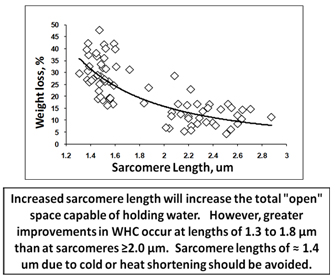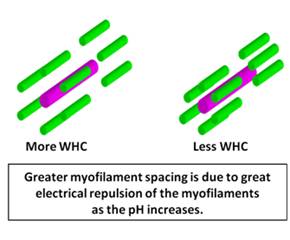How is Water Held in Meat?
-
Space (Steric or Spatial) Effect:
- Longer sarcomeres: provides more space for holding water
- Greater myofilament spacing: also increases space for water
- Actually, there is an interaction between a and b.
Overall, the thousands of tiny spaces (Fig. III-1) within myofibrils, between myofibrils, between the myofibrils and the cell membrane, and between individual cells and bundles of cells and the connective tissue layers of skeletal muscle are critical parts of the WHC of meat. Any processing that damages these compartments, denatures the protein or decreases the total space in these compartments will lower WHC. The factor of "space" is harder to manage than the net charge effect because its effects extend back to the farm (genetics, animal handling, and nutritional status), to slaughter operations (especially timely meat chilling and processing), and to final product manufacture and marketing. Chilling and pH monitoring can play a huge role in maintaining this part of WHC because it also has affects on the net charge mechanism of WHC.


Figure III-1. Effects of sarcomere length from normally chilled carcasses and pH related electrostatic repulsion of strands of myofilaments on water losses in meat.
- The Net Charge Effect - a Protein x Water Interaction: This mechanism of water holding has major effects on meat purge losses and cooking yields and it is one that can be influenced by processing conditions and added ingredients.
The principles of this mechanism are relatively simple but hard to control because so much of it is microscopic and subtle chemistry and physics. Opposite electrical charges on meat components attract and may hold water (see Figs. I.2, I.3, I.5). Conversely, similar charges on components are repulsive and cause the charged components to spread apart. Microscopic analysis of this phenomena show that distances between sarcomeric myofilaments, providing more room for water to be held. This enlargement (sarcomere swelling) especially the width of sarcomeres can only happen if the proteins have not been denatured by the drop in pH during rigor mortis or by cooking or other denaturing conditions.
Because water is dipolar and meat proteins are normally negatively charged, parts of the system can exert holding or repulsive forces. Overall, the meat system is usually higher than the isoelectric pHI, so the system is in a net negative state. However, this becomes more complex because many other factors affect the system (see previous sections).
Overall, the water holding system is a delicate balance that can change quickly. There is no substitute for trying to keep the muscle structure intact and to diligently process meat to have the longest sarcomere length possible, to modulate the interaction between muscle acidity and pH to provide an electrostatic arena where water is restricted in its movement.